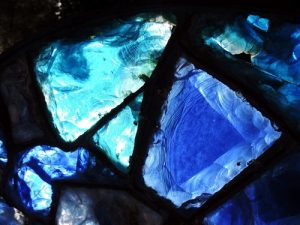
1. Origins of Stained Glass
The origins of stained glass can be traced back to the ancient world, with early examples found in Egyptian and Roman civilizations. However, it was during the medieval period that stained glass truly flourished. The rise of Gothic architecture in Europe led to the use of stained glass windows in churches and cathedrals as a way to tell biblical stories and teach illiterate congregations. These stunning works of art allowed light to pass through, creating a heavenly aura and transforming the atmosphere within these sacred spaces.
2. Masterpieces of Gothic Stained Glass
From the 12th to the 16th centuries, Gothic stained glass reached its zenith in Europe. The windows of Chartres Cathedral in France, for example, are renowned for their breathtaking beauty and storytelling prowess. These glass panels depicted scenes from the Bible and the lives of saints, using rich colors and intricate details to convey a sense of divine splendor. The skill and artistry of the craftsmen who created these masterpieces continue to inspire awe and admiration to this day.
3. Renaissance Revival
During the Renaissance, stained glass underwent a transformation influenced by the changing artistic trends of the time. The focus shifted from the narrative storytelling of the Gothic period to a more classical and symbolic approach. Artists used stained glass as a medium for allegorical representations and decorative elements in palaces, mansions, and religious buildings. Renaissance stained glass windows became more refined, featuring elegant figures, intricate patterns, and vibrant colors that reflected the rebirth of classical ideals.
4. Cultural Influences
Stained glass has not only played a significant role in religious contexts but also in various cultural movements throughout history. Islamic art, for instance, has long been renowned for its exquisite tiled mosaics and intricate geometric patterns. These influences can be seen in stained glass art from regions where Islamic culture has left its mark, such as Spain and North Africa. The interplay of colors and geometric shapes in Islamic stained glass beautifully marries artistic expression with cultural heritage.
5. Art Nouveau and Tiffany Stained Glass
In the late 19th and early 20th centuries, a new era of stained glass emerged with the Art Nouveau movement. Artists such as Louis Comfort Tiffany embraced organic forms, flowing lines, and nature-inspired motifs to create stunning stained glass masterpieces. Tiffany glass, known for its iridescent qualities, introduced a new level of artistry and innovation. These mesmerizing works of art adorned the windows of homes, public buildings, and even luxury ocean liners, bringing a touch of elegance and beauty to everyday life.
6. Contemporary Stained Glass Art
While stained glass has deep roots in history, its artistic potential continues to evolve in the modern era. Contemporary artists experiment with new techniques, materials, and interpretations, pushing the boundaries of traditional stained glass. From abstract designs to three-dimensional installations, stained glass is now used in innovative ways, both to enhance architectural spaces and as independent art forms. The versatility of stained glass allows for a broad range of artistic expressions that capture the imagination and provoke thought.
7. Preservation and Restoration
Preserving and restoring stained glass is crucial to maintain these works of art for future generations. Many historic buildings and churches have dedicated efforts to protect their precious stained glass windows. Skilled artisans work meticulously to repair damaged pieces, replace broken glass, and ensure the structural integrity of these delicate artworks. Through these restoration efforts, the beauty and cultural significance of stained glass are preserved, allowing us to experience the artistry of the past in the present.
Summary
Stained glass is a testament to the creativity, craftsmanship, and cultural impact of artists throughout history. From its origins in medieval cathedrals to its application in modern art, stained glass continues to capture our imagination with its mesmerizing colors and intricate designs. As we appreciate the artistic legacy of stained glass, we recognize its power to transcend time, enrich our understanding of history and culture, and inspire generations to come.
Need Stained Glass In Prunedale, CA?
Since 1978 Smiths’ Stained Glass has been crafting beautiful stained glass pieces for residential and commercial clients. Locally owned and operated by the Smith family, we provide stained glass and supplies to the Monterey County, CA area. Specializing in an array of stained glass services, Smiths’ Stained Glass offers custom window designs, glass repair, workshops and more. If you would like to learn more about our passion for stained glass or fuel your own, we can teach you how to create your own stunning glass pieces! Classes are available throughout the year and are offered at multiple convenient times to work with your schedule. Contact us today to learn more!
